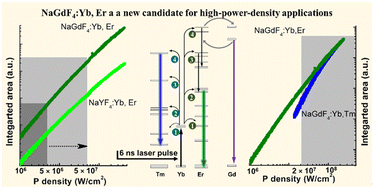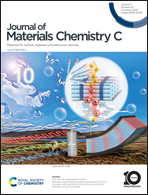Gd–Er interaction promotes NaGdF4:Yb, Er as a new candidate for high-power density applications†
Abstract
High-power density applications using up-conversion (UC) systems rely mostly on the Yb, Tm lanthanide couple. Herein, we investigate the extent to which Gd high energy levels can enhance the four-order UC process in NaGdF4:Yb, Er under pulsed excitation, making the Yb, Er UC system suitable for high power density applications. Unlike cw excitation, pulsed laser excitation enables higher equivalent power densities with reduced local heating effects. We found that Gd upholds the saturation level by one order of magnitude in NaGdF4:Yb, Er@NaYF4 compared to NaYF4:Yb, Er@NaYF4 nanoparticles, i.e., from 5 × 106 to 5 × 107 W cm−2. Such an effect is determined by efficient two-step Er–Gd energy transfer, in which the Gd levels, populated by four-order Yb–Er processes, act further as the long(est)-lived reservoir level for Er UC emissions. Notably, above 108 W cm−2, NaGdF4:Yb, Er@NaYF4 shows similar performance to NaGdF4:Yb, Tm@NaYF4 in terms of UC photon order, which is considered a direct indicator of spatial resolution in high power density applications. Our results showcase the promise of the Yb, (Gd) Er UC system for high power density applications, thus stimulating research for expanding the presently limited range of applicable UC systems.



 Please wait while we load your content...
Please wait while we load your content...